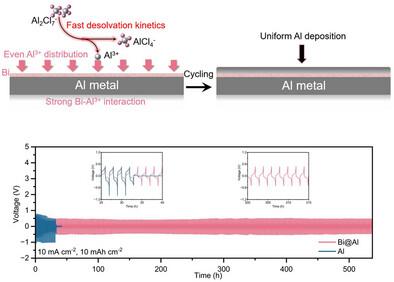A Bismuth Surface Layer Enables Uniform Aluminum Electrodeposition for Reversible Aluminum Metal Anodes
IF 12.1
2区 材料科学
Q1 CHEMISTRY, MULTIDISCIPLINARY
引用次数: 0
Abstract
Metallic aluminum (Al) is an attractive anode material for Al-ion batteries owing to its high theoretical capacity and low cost. However, Al metal anodes suffer from surface passivation, dendrite growth, and parasitic reactions, hindering the practical applications of Al-ion batteries. Herein, a modified Al metal anode with a bismuth (Bi) artificial surface layer (Bi@Al) is developed by a facile in-situ substitution reaction method. The Bi layer accelerates the desolvation, nucleation, and Al3+ migration process, thereby facilitating homogeneous Al3+ distribution and rapid Al plating/stripping. Therefore, the modified Al metal anode achieves high reversibility and stability even under high current densities and capacities. As a result, Bi@Al symmetric cells exhibit a lifespan over 500 h at 10 mA cm−2 and 10 mAh cm−2. Furthermore, combined with the graphite cathode, the Bi-modified Al metal full cell delivers a capacity of 80.1 mAh g−1 after 1000 cycles at 1.0 A g−1. This work provides a valuable method to modify the Al metal anode for developing high-performance non-aqueous Al-ion batteries.

铋表面层使可逆铝金属阳极的铝电沉积均匀
金属铝具有理论容量大、成本低等优点,是一种极具吸引力的锂离子电池负极材料。然而,Al金属阳极受到表面钝化、枝晶生长和寄生反应的影响,阻碍了Al离子电池的实际应用。本文采用原位取代反应方法制备了一种具有铋(Bi)人工表面层(Bi@Al)的改性Al金属阳极。Bi层加速了脱溶、成核和Al3+迁移过程,从而促进了Al3+的均匀分布和Al的快速镀/剥离。因此,即使在高电流密度和高容量下,改性铝阳极也具有很高的可逆性和稳定性。结果,Bi@Al对称电池在10 mA cm - 2和10 mAh cm - 2下的寿命超过500小时。此外,与石墨阴极结合,bi修饰的Al金属全电池在1.0 a g−1下循环1000次后提供80.1 mAh g−1的容量。这项工作为开发高性能非水铝离子电池提供了一种有价值的改性铝阳极的方法。
本文章由计算机程序翻译,如有差异,请以英文原文为准。
求助全文
约1分钟内获得全文
求助全文
来源期刊

Small
工程技术-材料科学:综合
CiteScore
17.70
自引率
3.80%
发文量
1830
审稿时长
2.1 months
期刊介绍:
Small serves as an exceptional platform for both experimental and theoretical studies in fundamental and applied interdisciplinary research at the nano- and microscale. The journal offers a compelling mix of peer-reviewed Research Articles, Reviews, Perspectives, and Comments.
With a remarkable 2022 Journal Impact Factor of 13.3 (Journal Citation Reports from Clarivate Analytics, 2023), Small remains among the top multidisciplinary journals, covering a wide range of topics at the interface of materials science, chemistry, physics, engineering, medicine, and biology.
Small's readership includes biochemists, biologists, biomedical scientists, chemists, engineers, information technologists, materials scientists, physicists, and theoreticians alike.
 求助内容:
求助内容: 应助结果提醒方式:
应助结果提醒方式:


